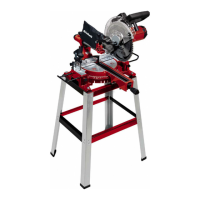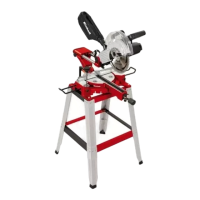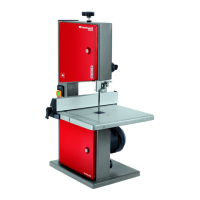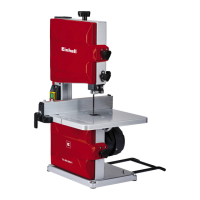GBGB
- 43 -
•
2 x workpiece support
•
Sawdust bag
•
Hexagon key
•
Round-head screw (24x)
•
Spring washer (24x)
•
Washer, small (24x)
•
Nut (24x)
•
Hex screw (4x)
•
Washer, large (8x)
•
Nut, large (4x)
•
Spring washer (4x)
•
Table width extensions (2x)
•
Locking screw (2x)
•
Original operating instructions
3. Proper use
The drag, crosscut and miter saw is designed
for cross-cutting wood and wood-type materials
which are appropriate for the machine’s size. The
saw is not designed for cutting rewood.
The equipment is to be used only for its pre-
scribed purpose. Any other use is deemed to be
a case of misuse. The user / operator and not the
manufacturer will be liable for any damage or inju-
ries of any kind caused as a result of this.
Please note that our equipment has not been de-
signed for use in commercial, trade or industrial
applications. Our warranty will be voided if the
machine is used in commercial, trade or industrial
businesses or for equivalent purposes.
The equipment is to be operated only with suit-
able saw blades. It is prohibited to use any type of
cutting-o wheel.
To use the equipment properly you must also
observe the safety information, the assembly
instructions and the operating instructions to be
found in this manual.
All persons who use and service the equipment
have to be acquainted with these operating
instructions and must be informed about the
equipment’s potential hazards. It is also impera-
tive to observe the accident prevention regula-
tions in force in your area. The same applies for
the general rules of health and safety at work.
The manufacturer will not be liable for any
changes made to the equipment nor for any
damage resulting from such changes. Even when
the equipment is used as prescribed it is still
impossible to eliminate certain residual risk
factors. The following hazards may arise in
connection with the machine’s construction and
design:
•
Contact with the saw blade in the uncovered
saw zone.
•
Reaching into the running saw blade (cut inju-
ries).
•
Kick-back of workpieces and parts of work-
pieces.
•
Saw blade fracturing.
•
Catapulting of faulty carbide tips from the saw
blade.
•
Damage to hearing if ear-muffs are not used
as necessary.
•
Harmful emissions of wood dust when used
in closed rooms.
4. Technical data
See warranty card of your country.
Wear ear-mus.
The impact of noise can cause damage to hea-
ring.
Total vibration values (vector sum of three direc-
tions) determined in accordance with EN 62841.
Vibration emission value a
h
< 2.5 m/s
2
K uncertainty = 1.5 m/s
2
The specied vibration value was established in
accordance with a standardized testing method. It
may change according to how the electric equip-
ment is used and may exceed the specied value
in exceptional circumstances.
The specied vibration value can be used to
compare the equipment with other electric power
tools.
The specied vibration value can be used for initi-
al assessment of a harmful eect.
Keep the noise emissions and vibrations to a
minimum.
•
Only use appliances which are in perfect wor-
king order.
•
Service and clean the appliance regularly.
•
Adapt your working style to suit the appliance.
•
Do not overload the appliance.
•
Have the appliance serviced whenever ne-
cessary.
•
Switch the appliance off when it is not in use.
Caution!
Residual risks
Even if you use this electric power tool in
accordance with instructions, certain resi-
dual risks cannot be rules out. The following
hazards may arise in connection with the
equipment’s construction and layout:
1. Lung damage if no suitable protective dust
mask is used.
2. Damage to hearing if no suitable ear protec-
tion is used.
3. Health damage caused by hand-arm vib-
rations if the equipment is used over a pro-
longed period or is not properly guided and
maintained.
5. Before starting the equipment
Before you connect the equipment to the mains
supply make sure that the data on the rating plate
are identical to the mains data.
Warning!
Always pull the power plug before making
adjustments to the equipment.
5.1 General information
•
The equipment must be set up where it can
stand securely, i.e. it should be bolted to a
workbench, a universal base frame or similar.
•
All covers and safety devices have to be pro-
perly fitted before the equipment is switched
on.
•
It must be possible for the blade to run freely.
•
When working with wood that has been pro-
cessed before, watch out for foreign bodies
such as nails or screws, etc.
•
Before you actuate the On/Off switch, make
sure that the saw blade is correctly fitted
and that the equipment’s moving parts run
smoothly.
5.2 Assembling the base frame
(Fig. 1, 4a – 4e)
•
Assemble the base frame as shown in Fig.
4a-4e. Attach the parts together using the
screws (a), spring washers (b), washers (c)
and nuts (d). Do not fully tighten the screws
yet.
•
Start with the top cross struts (101) and the
top longitudinal struts (102) followed by the
leg upper sections (105).
Anl_TC_SM_2531_2_U_SPK8.indb 43Anl_TC_SM_2531_2_U_SPK8.indb 43 30.06.2021 08:18:5930.06.2021 08:18:59
